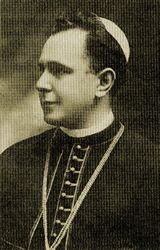Julius Glattfelder
Julius Glattfelder (born March 18, 1874 in Budapest , Hungary ; † August 30, 1943 in Szeged , Hungary) was a bishop , educator , writer and church politician .
Life
In Timisoara
Julius Glattfelder was born in Budapest in 1874 as the son of a German industrialist and a Magyar mother, where he graduated from the Lyceum and studied theology . In 1896 he was ordained a priest . Even as a young priest he was an excellent youth pastor, priestly educator , founder of the St. Emmerich College for Students, editor of the magazine Örökirnádás ( Eternal Adoration ). In 1904 he became a secret papal chaplain ad hon. During this time he had the Emericaneum built and promoted the publication of theological magazines. In 1909 he was appointed professor at the Catholic Theological Faculty of the University of Budapest and on March 8, 1911, he was ordained bishop of the Csanád diocese . The enthronement took place on May 28, 1911 in the Roman Catholic Cathedral in Timisoara. The construction of the new Catholic seminary in Timișoara goes back to the initiative of Bishop Julius Glattfelder . On August 15, 1920 he decided to set up a denominational German teacher training institute in Timisoara. Classes began on November 3, 1920 in Tigergasse .
The end of the First World War brought the diocese of Csanád into three parts. The tripartite division of the Banat resulted in the Csanáder diocese extending over 3 countries. 33 parishes and the city of Szeged remained with Hungary . From 1923 the Bishop of Csanád also resided in Szeged. 64 parishes with the center in Zrenjanin were incorporated into the Serbian Kingdom . In 1988 the diocese of Zrenjanin was established in this area. The largest area of the former Csanáder diocese, 163 parishes with the center in Timișoara , was assigned to the Kingdom of Romania .
In Szeged
After Bishop Julius Glattfelder sharply criticized the Romanian government's school and agricultural reform in a pastoral letter in 1922 , he was deported to Hungary. On February 17, 1923, the Bucharest Apostolic Nuncio appointed Canon Augustin Pacha as Apostolic Administrator of the part of the Csanád diocese that remained in Romania. Glattfelder said goodbye to Timișoara on March 11, 1923 with a solemn high mass. On March 25, 1923, he moved from Timișoara to Szeged, where he served as bishop of the remaining Hungarian diocese of Csanád for over 20 years. There he built a new diocese out of the remaining diocese: cathedral , seminary , bishop's residence and parish organization.
Julius Glattfelder was also a writer with 228 publications and 64 pastoral letters. Also an excellent preacher and church politician . Glattfelder became a member of the upper house of the Hungarian parliament in 1927 . In 1942 he was appointed Archbishop of Kalocsa , but could no longer take over his office due to illness.
Bishop Julius Glattfelder died on August 30, 1943 in Szeged and was buried in the local cathedral crypt. The remaining Hungarian diocese of Csanád was transformed into a new diocese in 1982, the diocese of Szeged-Csanád.
literature
- István Zombori (Ed.): Igazságot szeretettel Glattfelder Gyula élete és munkássága. (Truth with love. Life and work of Gyula Glattfelder.) Magyar Egyháztörténeti Enciklopédia Munkaközösség / Katolikus Értelmiségi Szövetség, Budapest / Szeged 1995, 203 pp.
- Koloman Juhász , Adam Shift: The Diocese of Timișoara-Timisoara. Past and present. Timișoara 1934, ISBN 3-922046-76-2 .
- Anton Peter Petri : Biographical Lexicon of the Banat Germans. Marquartstein 1992, ISBN 3-922046-76-2 .
- Stephan O. Schüller: For faith, leaders, people, fatherland or motherland? The struggles for German youth in the Romanian Banat (1918–1944). LIT Verlag, Münster 2006, ISBN 978-3-8258-1910-1 , p. 25.
Web links
- Entry on Gyula Glattfelder on catholic-hierarchy.org ; accessed on August 18, 2016.
- Hungary Yearbook 1995–1996. (PDF; 423 kB)
- Dr. Julius Glattfelder, Edler von Mór. In: Banater Info.
Individual evidence
- ^ Immo Eberl : Examples of folklore: house forms, traditional costumes and folk theater. Section 60: Church Situation.
| predecessor | Office | successor |
|---|---|---|
| Ján Černoch |
Bishop of Csanád 1911–1943 |
Sándor IV. Raskó |
| personal data | |
|---|---|
| SURNAME | Glattfelder, Julius |
| ALTERNATIVE NAMES | Glattfelder, Gyula |
| BRIEF DESCRIPTION | Hungarian clergyman, Roman Catholic bishop |
| DATE OF BIRTH | March 18, 1874 |
| PLACE OF BIRTH | Budapest , Hungary |
| DATE OF DEATH | August 30, 1943 |
| Place of death | Szeged , Hungary |

